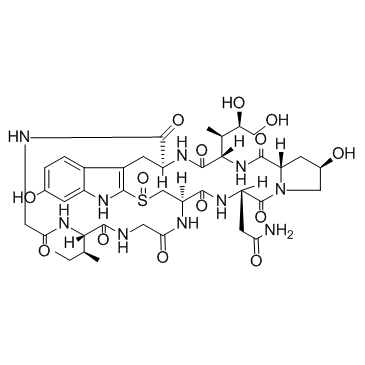23109-05-9
| Name | α-amanitin |
|---|---|
| Synonyms |
α-Amanitin,cyclo[L-Asparaginyl-4-hydroxy-L-proly-(R-4,5-dihydroxy-L-isoleucyl-6-hydroxy-2-mercapto-L-tryptophylglycyl-L-isoleucylglycyl-L-cysteinyl]cyclic(4-8)-sulfide(R)-S-oxide
alpha-amanitin MFCD00215842 EINECS 245-432-2 A-AMANITIN AMANITIN,A |
| Description | alpha-Amanitin is the principal toxin of several deadly poisonous mushrooms, exerting its toxic function by inhibiting RNA-polymerase II. |
|---|---|
| Related Catalog | |
| Target |
ADCs cytotoxin, RNA-polymerase II[1] |
| In Vitro | Alpha-Amanitin decreases TAF15 mRNA and TAF15 protein levels in MKN45 cells, and inhibits the RNAPII activity towards TAF15 mRNA[2]. alpha-Amanitin decreases cell viability by 14%, 21%, 41%, 44%, and 50% at concentrations of 100, 10, 1, 0.1, and 0.01 µg/mL, respectively. The LD50 of the alpha-Amanitin at 36 h is measured as 1 µg/mL. The total amount of protein within the cell at 24 h is significantly increased for the 1 µg/mL dose of alpha-Amanitin compared to the control[3]. Alpha-Amanitin dramatically decreases the expression of gap junctional genes (Gja1, Gja4 and Gjc1) and gonadotropin receptor genes (FSHr and LHr) in cumulus cells[4]. |
| In Vivo | The intravenous LD50 dose of alpha-Amanitin is 0.327 mg/kg body weight after intravenous injection into BALB/c mice. After 12 h of alpha-Amanitin injection in caudal vein, the levels of WBC, RBC and HGB decrease significantly, while those of BUN and Crea increase significantly in serum. alpha-Amanitin inhibits some genes (Hsp90b1, Irx4, etc.), whose encoded proteins regulate the RNA polymerase II activity. alpha-Amanitin down-regulates some proteins (Nmi, Trpc5, etc.) taking part in the transcription progress[1]. alpha-Amanitin has potent activity in DTC suppression. Mice injected with alpha-Amanitin (0.4 mg/kg, i.p.)-treated cells maintain their body weight, while those receiving a peritoneal injection of MKN45 cells show a constant decrease in body weight[2]. |
| Cell Assay | The MTT assay is used to evaluate the overall functional integrity and viability of the cultured cells. The MCF-7 cells are put into 96-well plates (2×104 for each well), which are incubated for 24 h. The specific concentrations of alpha-Amanitin and β-Amanitin are added to the cell culture medium, and plates are incubated for an additional 36 h. MTT solution (1:10 ratio) and dimethyl sulfoxide (DMSO) (100 µL) are then added to the cell culture medium and plates are incubated overnight. The absorbance is measured at 570 nm on a plate reader. This experiment is repeated 3 times. The absorbance data are calculated as percentages according to the control group. |
| Animal Admin | For tumorigenicity tests, six colonies (untreated) and DTCs derived from MKN45 cells are individually injected subcutaneously into the left and right side of the backs of six 6-week-old female nude mice (BALB/cAjcl-nu/nu). These mice are monitored for 49 days after the inoculation or until tumors reach 10 mm in the largest diameter, and are then euthanized. For the PC model, 1.0×106 MKN45 cells are injected intraperitoneally into six 6-week-old female nude mice (BALB/cAjcl-nu/nu). Mice are then treated with CIS (4.0 mg/kg, intraperitoneal administration) or a combination of CIS and alpha-Amanitin (0.4 mg/kg, intraperitoneal administration). For the combination treatment, alpha-Amanitin is given 24 hours before CIS. Body weight is monitored for 28 days after the treatment. |
| References |
| Density | 1.57 g/cm3 |
|---|---|
| Boiling Point | 1622.2ºC at 760 mmHg |
| Melting Point | 254-255ºC(lit.) |
| Molecular Formula | C39H54N10O14S |
| Molecular Weight | 918.97000 |
| Flash Point | 934.9ºC |
| Exact Mass | 918.35400 |
| PSA | 400.09000 |
| Index of Refraction | 1.694 |
CHEMICAL IDENTIFICATION
HEALTH HAZARD DATAACUTE TOXICITY DATA
MUTATION DATA
|
| Symbol |


GHS06, GHS08 |
|---|---|
| Signal Word | Danger |
| Hazard Statements | H300-H310-H330-H373 |
| Precautionary Statements | P260-P264-P280-P284-P301 + P310-P302 + P350 |
| Personal Protective Equipment | Eyeshields;Faceshields;Gloves;type P2 (EN 143) respirator cartridges |
| Hazard Codes | T+: Very toxic; |
| Risk Phrases | R26/27/28 |
| Safety Phrases | 36/37/39-45-36/37-28 |
| RIDADR | UN 3462 6 |
| WGK Germany | 3 |
| RTECS | BD6195000 |
| Packaging Group | I |
| Hazard Class | 6.1(a) |
